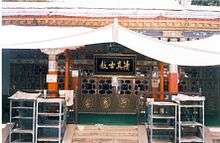Tibetan Muslims
Tibetan Muslims, also known as the Kachee (Tibetan: ཁ་ཆེ་, Wylie: kha-che ; also spelled Kache), form a small minority in Tibet. Despite being Muslim, they are officially recognized as Tibetans by the government of the People's Republic of China, unlike the Hui Muslims, who are separately recognized. The Tibetan word Kachee literally means Kashmiri and Kashmir was known as Kachee Yul (Yul means Country).
| Part of a series on Islam in China | ||||||
|---|---|---|---|---|---|---|
 | ||||||
|
||||||
|
| ||||||
History

The first contacts with Tibet and the Islamic world began around the mid-eighth century when it grew out of a combination of trade via the Silk Road and the military presence of Muslim forces in the Fergana Valley. Despite the vague knowledge the Islamic world had about Tibet, there were a few early Islamic works that mention Tibet. One such source is from a work authored by Abu Sa'id Gardezi titled Zayn al-Akhbar. In it, the work mentions the environment, fantastical origin of the Tibetans (through the Himyarites), the divinity of the king, major resources (like musk) and a description of the trade routes to and from Tibet. Another source, Hudud al-'Alam (The Regions of the World) written by an unknown author in 982 or 983 in Afghanistan, contains mainly geography, politics and brief descriptions of Tibetan regions, cities, towns and other localities. This source has the first direct mention of the presence of Muslims in Tibet by stating that Lhasa had one mosque and a small Muslim population.[1]
During the reign of Sadnalegs (799-815), there was a protracted war against Arab powers to the West. It appears that Tibetans captured a number of Arab troops and pressed them into service on the eastern frontier in 801. Tibetans were active as far west as Samarkand and Kabul. Arab forces began to gain the upper hand, and the Tibetan governor of Kabul submitted to the Arabs and became a Muslim about 812 or 815 [2]
Extensive trade with Kashmir, Ladakh, and Baltistan also brought Muslims to Tibet especially after the adoption or growing presence of Islam in these regions starting from the fourteenth century. The ongoing growth of Muslims continued as an affect of the Tibetan-Ladakhi treaty of 1684 in which the Tibetan government allowed trade missions from Ladakh to enter Lhasa every three years. Many Kashmiri and Ladakhi Muslims joined these missions with some settling in Tibet.[3]
During the reign of the Dalai Lama Ngawang Lobsang Gyatso (1617-1682), a permanent Muslim community settled down in Tibet. They were permitted to elect their own council of representatives, settle their group's legal disputes with Islamic law, and some land was donated to them for the construction of a mosque close to Lhasa.[4]
An influx of Kashmiri Muslims in Nepal (originally having trade contacts with their kin in Tibet) fled to Tibet starting from 1769 as a consequence of the invasion of the Kathmandu Valley by Prithvi Narayan Shah. As early as the seventeenth century, Ningxia and other northwestern Hui (Chinese Muslims) began to settle in the eastern regions of Tibet (like in Amdo). They intermarried with the local Tibetans and continued to have to extensive trade contacts with other Muslims inside China.[3]
Another recent wave of new Muslim settlers began after the Dogra conquest of Tibet in 1841. Many Kashmiri and Ladakhi Muslim troops (who were taken as prisoners when fighting against the Dogra army) stayed behind to settle in Tibet. A few Hindu Dogras also settled in Tibet and subsequently converted to Islam.[3]
After the Chinese conquest of Tibet in 1950, the Tibetan Muslims faced brutal persecution just like their Buddhist brethren. Since then, Chinese Muslims (along with the Han and others) have settled in Tibet.[3] The Chinese government classified the Tibetan Muslims as Hui. However, the Tibetan Muslims are often called Zang Hui (Tibetan Hui) as they speak Tibetan and have a material culture almost identical to their Buddhist counterparts. The Tibetan Hui in Lhasa (unlike other Tibetan Muslims living elsewhere) consider themselves to be very different from the Chinese Muslims and sometimes marry with other Tibetans (including Buddhist) instead of their fellow Muslims from China.[5]
Converts in Qinghai
Islam was spread by the Salar people to the formerly Buddhist Kargan Tibetans in Lamo-shan-ken.[6][7] Some Tibetans in Qinghai who converted to Islam are now considered Hui people.[8][9]
Balti people
The Balti people of Baltistan in Pakistan and Kargil in India are descendants of Tibetan Buddhists who converted to Noorbakshia sect of Islam . With the passage of time a large number converted to Shia Islam, and a few converted to Sunni Islam. Their Balti language is highly archaic and conservative and closer to Classical Tibetan than other Tibetan languages.
See also
References
Citations
- Schaeffer, Kurtis; Kapstein, Matthew; Tuttle, Gray (2013). Sources of Tibetan Tradition. New York: Columbia University Press. pp. 24–29. ISBN 978-0-231-13599-3.
- Beckwith, Christopher I. The Tibetan Empire in Central Asia. A History of the Struggle for Great Power among Tibetans, Turks, Arabs, and Chinese during the Early Middle Ages, 1987, Princeton: Princeton University Press. ISBN 0-691-02469-3, p. 14, 48, 50.
- Berzin, Alexander. "History of the Muslims of Tibet". studybuddhism.com. Retrieved 22 October 2019.
- Schaik van, Sam (2011). Tibet: A History. New Haven: Yale University Press. p. 128. ISBN 9780300194104.
- Gladney, Dru (1996). Muslim Chinese: Ethnic Nationalism in the People's Republic (2 ed.). Cambridge: Harvard University Press. pp. 33, 34, 36. ISBN 0-674-59497-5.
- The Geographical Journal. Royal Geographical Society. 1894. pp. 362–.
- The Geographical Journal. Royal Geographical Society. 1894. pp. 362–.
- 樊, 前锋 (2008-06-18). "青海,那些说藏语的回族乡亲". 中国民俗网.
- "青海,那些讲藏话的回回". 宁夏新闻网. 2008-06-19.
Sources
- Akasoy, Anna; Burnett, Charles; Yoeli-Tlalim, Ronit. (2016). Islam and Tibet: interactions along the musk routes. Routledge, 2016. ISBN 978-1-138-24704-8.
- Atwill, David G. “Boundaries of Belonging: Sino-Indian Relations and the 1960 Tibetan Muslim Incident.” The Journal of Asian Studies 75, no. 03 (August 2016): 595–620, doi:10.1017/S0021911816000553.
- Sheikh, Abdul Ghani. (1991). "Tibetan Muslims." The Tibet Journal. Vol. XVI, No. 4. Winter, 1991, pp. 86–89.
- Siddiqui, Ataullah. (1991). "Muslims of Tibet." The Tibet Journal. Vol. XVI, No. 4. Winter, 1991, pp. 71–85.
External links
- Tibetan Muslims
- Islam in Tibet: Preface by His Holiness The Dalai Lama; Including 'Islam in the Tibetan Cultural Sphere'; 'Buddhist and Islamic Viewpoints of Ultimate Reality'; and The Illustrated Narrative 'Tibetan Caravans'- Fons Vitae books
- Islam in Tibet 'The Ornaments of Llasa' Video - Fons Vitae books
- Gallery of Tibet (Includes picture of a Minaret)
- Mosque in Lhasa
- Islam and Tibet: cultural interactions, 8th to 17th centuries
- Exploring Ethnicities: A Sociological Profile Of Tibetan Muslim Community In Kashmir Valley – Analysis
- A minority within a minority: Nepal’s Tibetan Muslims mark Ramadan